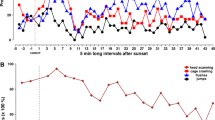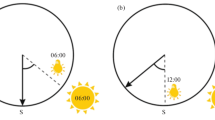Abstract
In the last 30 years, lunar orientation has received little attention from students of animal orientation. Even in Talitrus saltator, the first animals in which the lunar compass was demonstrated, research did not continue. Our studies have demonstrated that: 1) chronometrically compensated lunar orientation is independent of the earth's magnetic field (an ever present non-chronometric orientation reference); 2) lunar orientation is independent of the lunar shape; and 3) the lunar compass is also used by young animals born in the laboratory (without experience in nature).
Similar content being viewed by others
Author information
Authors and Affiliations
Additional information
Accepted: 30 September 1998
Rights and permissions
About this article
Cite this article
Ugolini, A., Melis, C. & Innocenti, R. Moon orientation in adult and young sandhoppers. J Comp Physiol A 184, 9–12 (1999). https://doi.org/10.1007/s003590050301
Issue Date:
DOI: https://doi.org/10.1007/s003590050301




